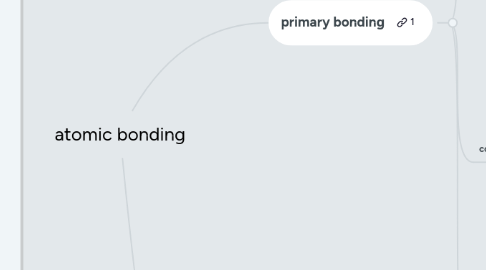
1. primary bonding
1.1. ionic bonding
1.1.1. metals+nonmetals bond through electron bonding
1.1.1.1. cation(nonmetal)
1.1.1.1.1. as an acceptor
1.1.1.2. anion(metal)
1.1.1.2.1. as a donar
1.1.2. force considerations
1.1.2.1. positive nucleus of one ion will attract the negative charge cloud of the other ion and vice versa
1.1.2.1.1. the interionic distance,a decreases
1.1.3. ion arrangement in ionic solids
1.1.3.1. a cation attracts anions from all directions & bonds with a many of them as possible (how the 3D structure formed )
1.1.3.1.1. number of cations that can pack around an anion
1.1.4. energy considerations in ionic solids
1.1.4.1. eg : LiF ionic solid
1.1.4.1.1. Hess law : total heat of formation of LiF should be equal of the heat formations required
1.1.4.2. lattice energies
1.1.5. material properties
1.1.5.1. high melting temperatures
1.1.5.2. hard(do not dent)
1.1.5.3. rigid(do not bend)
1.1.5.4. brittle (deform little before fracture)
1.1.5.5. excellent insulators
1.1.5.5.1. electrons are tightly held inside the bond&cannot participate in the conduction process
1.1.5.6. conductive when liquid
1.1.5.6.1. eg : molten NaCI
1.1.5.6.2. ions are free to move
1.2. covalent bonds
1.2.1. mostly between nonmetals
1.2.1.1. polar
1.2.1.1.1. less electronegative+electronegative atoms
1.2.1.2. nonploar
1.2.1.2.1. contains atoms with same electronegativety
1.2.2. in carbon-containing molecules
1.2.2.1. can form 4 covalent tetravalence by sharing
1.2.2.1.1. does not gain
1.2.2.1.2. does not lose
1.2.3. in hydrocarbons
1.2.4. and material properties
1.2.4.1. poor conductors
1.2.4.1.1. electrons are tightly bonded in the shared pairs +no ions are available for charge transport
1.2.4.2. network covalent solids
1.2.4.2.1. eg:quartz
1.3. metallic bonds
1.3.1. metal+metal
1.3.1.1. the electrostatic attraction between metal ions arranged in the lattice structure and free-floating electron
1.3.2. material properties
1.3.2.1. Melting point is high
1.3.2.1.1. not required to break the bond between the ionic core and electron core
1.3.2.2. malleable
1.3.2.2.1. the strong bonding is retained even when the metal is stressed
1.3.2.3. soft and deformable
1.3.2.4. excellent conductors of electricity
1.3.2.4.1. the decolized nature of the valence electrons
1.3.2.5. excellent conductors of heat
1.3.2.5.1. the efficient transfer of thermal atomic vibrations across the metal
2. secondary bonding
2.1. known asVan Der Waals
2.1.1. relatively much weaker than primary
2.1.1.1. because there is no exchange of electrons
2.2. driving force
2.3. electric dipoles
2.3.1. created in atoms/molecules when + and - charge centers exist
2.3.1.1. fluctuating dipoles
2.3.1.2. permanent dipoles
